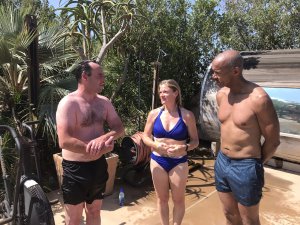Using Nasal Breathing to Self-Monitor, and Increase Attention
In previous posts on breathing, we’ve explored the physical impact of nasal breathing for performance and recovery. Now, Patrick McKeown—XPT advisor and author of The Oxygen Advantage: Simple, Scientifically Proven Breathing Techniques to Help You Become Healthier, Slimmer, Faster, and Fitter—is back to discuss how breathing is tied to your brain’s self-monitoring system. Specifically, the link between breath and movement quality, and how you can utilize nasal breathing to boost focus. He’ll also discuss mouth breathing and anxiety, and other benefits of nasal breathing patterns.
XPT: How can someone use their breath to increase attention?
PM: If your mind is all over the place, you won’t be able to concentrate on the task at hand. To do anything well in life—whether it’s training, working, or learning—you cannot have a distracted mind. To perform quality work, 100% of our attention and focus must be on the task. If we are living in our minds and our attention is occupied by repetitive internal dialogue, our ability to focus is diminished and quality of work suffers.
The world we live in and the technology we use are increasingly distracting. Social media alerts, emails and text messages all serve to distract us on a continuous basis. How many times per day do you flit from your work to check emails, your phone or social media, even though you might have only checked them a few minutes before? Unless we have awareness of time utilization, it is likely much of our day will be spent on non-productive distractions.
As human beings, we crave attention, and may unconsciously rely on social media to fill the void. Focusing on calm, controlled nasal breathing trains your brain to concentrate on something specific without your focus diminishing. It takes your attention away from external things that are trying to divert you and brings it inward. That can transfer to whatever you want to do better. Don’t wait until game day—get started now!

XPT: If someone’s struggling with performance anxiety, can breathing also help with that?
PM: Certainly! When you slow down your breath, it doesn’t just send signals to the breathing center in the brain—it also indicates the rest of the brain should calm down, too. There’s proven links between nasal breathing and anxiety reduction, demonstrated at a cellular level in a Stanford University study.
A structure in the brain is tasked with spying on breathing. When we breathe fast, this structure relays signals of agitation to the rest of the brain. Conversely, when we slow down our breathing, signals of calm and rest are directed throughout the brain. Through the breath, it seems that the brain can regulate its own excitability.
We also shouldn’t overlook the role of how you sleep the night before your event. If you breathe through your mouth all night, your sleep quality will diminish, which will in turn affect your mood the next day. You’re more likely to be agitated and anxious, and will struggle with focus and decision-making. And that’s before we get to the physical effects, like increased chance of injury!
Breathing through your nose throughout the day and night, then focusing on taking deep, slow nasal breaths before your event is a must. On the other hand, if you’re taking quick, shallow breaths through your mouth, you’re just feeding back into the stress loop.
XPT: What’s the relationship between breath pattern and movement quality?
PM: You can only move well if you’re breathing well. The two are indivisible. When you breathe through your nose you activate the diaphragm, which is directly correlated to core strength, stability of the trunk, spinal mechanics and motor control. A study showed that athletes with the lowest scores in the Functional Movement Screen (FMS) also had breathing-related issues.
The most fundamental factor here is mouth breathing. Habitual breathing through an open mouth activates the upper chest and causes faster breathing. If an athlete struggles with dysfunctional breathing patterns, they’re also likely to have dysfunctional movement. This decreases their power output and increases their risk of injury.
Dysfunctional breathing at rest translates into inefficient breathing during physical exercise. The athlete is more likely to experience premature breathlessness and muscle fatigue, and doing so puts them at an athletic disadvantage. Whereas when you breathe through your nose during wakefulness and sleep, you’re encountering resistance to your breathing that increases the load on the primary respiratory muscles and helps to maintain the tone and activation of the diaphragm. This will help you maintain stability in every body position, even at higher levels of exertion.
Breathing sets the limit of your exercise capacity and movement quality.

XPT: How is breathing tied into your body’s ability to self-monitor?
PM: It’s a crucial input that helps your body and brain determine everything from autonomic nervous system tone, to cardiovascular function, to mental state.
Your largest blood vessels contain baroreceptors that are constantly keeping tabs on blood flow and blood pressure. When pressure increases, they notify the brain. It then sends back a signal to open up your blood vessels and slow down your heart rate. Conversely, when pressure decreases, the signal comes back from the brain to constrict the blood vessels and increase your heart rate. Your breathing is on the front end of this process and determines how these baroreceptors are stimulated. By slowing down your breathing to a cadence of six breaths per minute, you can stimulate the baroreceptors to help restore autonomic functioning.
Research shows that people suffering from fibromyalgia, depression, anxiety, poor athletic ability, and a wide range of other conditions have poorly functioning baroreceptors. Nasal breathing isn’t a cure-all necessarily, but learning how to breathe through nose instead of mouth is a good place to start.
XPT: How does breathing impact heart rate variability (HRV)?
PM: We cannot consider HRV without thinking about breath. There’s strong evidence that connects greater heart rate variability to slow breathing. In order to breathe slowly and to use the diaphragm, nasal breathing is imperative.
Experiments by Paul Lehrer and others asked participants to match slow breaths with visual display of their heartbeats, and doing so increased HRV. One of Lehrer’s studies suggests that a rate of six to seven breaths per minute leads to optimal heart rate variability.
Beyond HRV, there are other connections between breathing and cardiovascular function. When you breathe through the nose, your breathing rate is usually lower. As there’s more time between each breath, there is a greater opportunity for oxygen to be transported through the airway, into the lungs, and into the bloodstream. Plus, nasal breathing allows sufficient carbon dioxide buildup to catalyze the release of oxygen in red blood cells, whereas mouth breathing removes too much CO2 from the lungs. This prompts you to breathe quicker and more intensely, and so the cycle continues.
It might seem counterintuitive, but the harder you breathe, the less oxygenated blood is making it to your muscles and brain.
